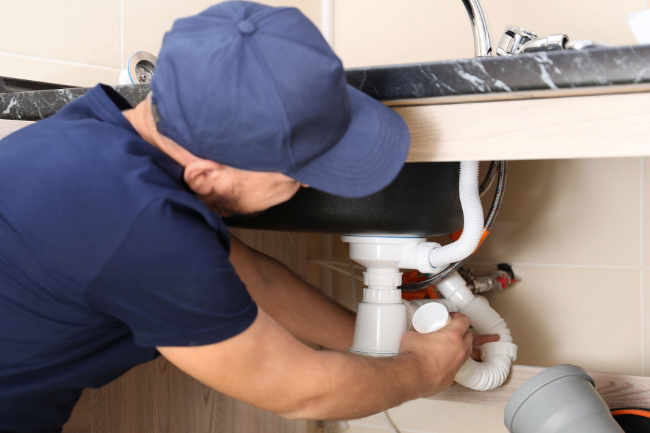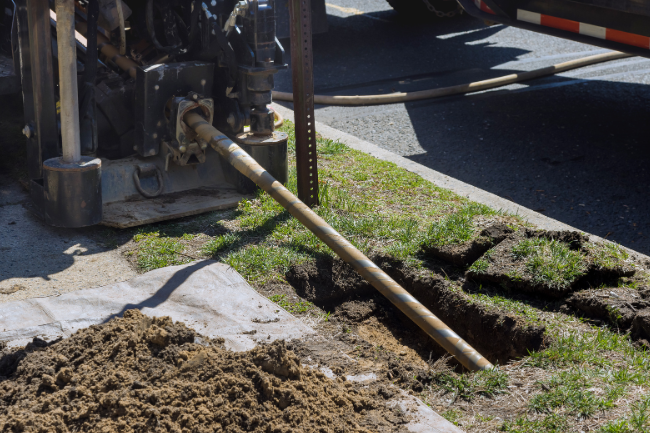Why is Directional Boring So Beneficial?
Posted by William Heinselman on
 When experiencing a damaged pipe, the stress involved can be almost incapacitating. Certain questions can come to mind: how much is a replacement pipe going to cost? How long is the process going to take? Will the replacement damage my property or the environment around it? These extra questions can cause a strong amount of worry, but trenchless technologies are the solution. Trenchless technologies are cost-effective, they do not take up more time than they need to, and they are safe for the environment. One such trenchless technology is directional boring, but what is directional boring, and what are the benefits?
When experiencing a damaged pipe, the stress involved can be almost incapacitating. Certain questions can come to mind: how much is a replacement pipe going to cost? How long is the process going to take? Will the replacement damage my property or the environment around it? These extra questions can cause a strong amount of worry, but trenchless technologies are the solution. Trenchless technologies are cost-effective, they do not take up more time than they need to, and they are safe for the environment. One such trenchless technology is directional boring, but what is directional boring, and what are the benefits?
What is Directional Boring?
Directional boring is another form of trenchless technology that is revolutionary in that it does not pose a threat to its surrounding environment. This means that it does not destroy your property and the process gives you better quality for your money. Directional boring with a Ditch Witch vehicle is a trenchless technology that can be steered by a driver, making it easier to maneuver than traditional trenchless technology. Even though it is a different process, it can still be used on sewer pipes, water pipes, conduits, and cables. It is used with a drilling rig, and is still friendly to the environment. The Ditch Witch trenchless technology brings the most benefit to larger projects.
Directional boring with Ditch Witch can be utilized with many different kinds of soil conditions, working in jobs including road, landscaping, and even river crossings. Pipes can be made of materials such as PVS, polyethylene, polypropylene, ductile iron, and even steel.
The Process of Directional Boring
Directional boring is a type of trenchless technology, and all trenchless technologies begin with an access point. This is usually in the form of a manhole, receiving hole, or a different form of an entrance pit. A pilot hole is dug for entry, and a second step dilates the hole with a larger cutting tool. The diameter is determined by the size of the pipe, and many different sizes of pipes can be repaired with the use of directional boring. The driller enlarges the diameter according to the kind of material that is being utilized to make the repairs. The third step is the placing of the new hole with a drill steel. It is then pulled behind the reamer to allow the pipe to center itself in its new environment.
Directional boring is highly compatible with infrastructure or municipal sewer systems. It can also be used in environmentally sensitive areas. Other places it can be used include:
- Crossings
- Waterways
- Roadways
- Shores
Directional boring is less intrusive in the surrounding roadways, meaning that driving patterns remain uninterrupted. It can also be completed in a shorter amount of time. The benefits continue to add up with trenchless technology.
Benefits of Directional Boring
The benefits of directional boring with Ditch Witch add to the benefits that already exist with the other trenchless technologies. The benefits include:
- No collateral damage to property
- No unnecessary traffic disruptions
- No commerce disruptions
- Greener and more sustainable
- Cost-efficient both now and later
With some processes that involve pipe repair, collateral damage may have been an unnecessary side effect of the work that had to be done. With directional boring, both the property and the surrounding environment are safe. Since the process is done without the need for trenches, roads do not need to be damaged or closed off, meaning your daily commute is protected, and drivers will have no problem getting to work. Since it protects the environment, it is greener and more durable. The durability is equivalent to the standard of high quality, proving that the process is effective for the price. The repaired pipes are guaranteed to last. With benefits like these, directional boring is not a failed technique.
What is CIPP?
CIPP, standing for cured-in-place piping, is one of many different trenchless technologies used to rehabilitate already existing pipelines. The results are guaranteed to last fifty years, meaning that they can last up to a lifetime. A common descriptive phrase is a pipe within a pipe. The process involves finding an access point, and inserting the small pipe inside the original pipeline. This technology has the capability to rehabilitate pipes of many different diameters, and can be used on many types of pipelines, including those that often come into contact with water, sewer, gasses, or chemicals. The new piping on the inside is without joints and without seams, meaning that the second pipe is more resistant to rust and leaks than its original counterpart. Other trenchless technologies include lateral reinstatement, manhole-to-manhole lining, sectional point repair, and pipe bursting.
CIPP was first implemented in 1971 in London, England. Since then it has become a revolutionary way to repair pipes without damaging the surrounding environment. This eco-friendly technology begins with a felt tube that is saturated in a protective layer of resin. The tube, made out of flexible polyester, is pulled into the damaged pipe. The lining can be placed with water or air pressure. The resin is then cured with hot water, UV light, or steam to attach it to the original pipe, forming a seal that fits the two pipes to each other tightly.
Benefits of CIPP
With cured-in-place piping, it is a trenchless technology, and thus does not require excavation or the digging of trenches to rejuvenate a pipeline. Excavations may be made but it is usually unnecessary and thus better and more efficient for the environment. A liner is installed through a manhole or other point of access. Liner is thus installed and the inside is repaired. Lateral connections are restored in sewer lines. This system utilizes a remote controlled device used to drill into a hole in the liner at the point of the lateral connection. With a smooth interior and no joints, the pipes being replaced and rejuvenated can last much longer, up to many decades. This type of trenchless technology can even repair a pipe with bends. The benefits can effectively reduce leaking and rusting, while preventing excessive damage in pipeline systems without the need to dig. Since the original pipe is being reinforced with a second pipe on the inside of a different material, the two materials work together and the original pipe is much safer and more durable. The materials are commonly effective when working with water, sewer, gas, and chemical piping.
Here at Express Sewer & Drain, we firmly believe that individuals as well as businesses can greatly benefit from methods of trenchless technology such as directional boring and piping that is cured in place. At an affordable cost, replacing pipes have become easier.
The utilization of trenchless technology is greener and does not destroy the areas around the pipe. No trench digging is necessary, and the effects stay beneficial in the long term. Cured-in-place piping is guaranteed to last over fifty years. The pricing of trenchless technology is cost-effective to rejuvenate miles of piping. Directional boring is revolutionary, efficient, and effective for the economy and the surrounding environment.
Topics: Trenchless Technology


![Repiping Your Sacramento Home [6 Steps]](https://www.expresssewer.com/hs-fs/hubfs/plumbing%20tools%20and%20blueprints.jpeg?width=550)




